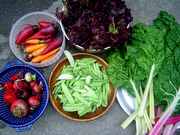

|
| Vegetable Varieties for Gardeners is a citizen science program
|
|
|
|
'Katahdin' Potatoes |
| |
| Sub-Category: |
Late Season
|
| |
|
| Sub-Category 2: |
| | Description: |
Late season. Large, round tubers with buff skin and moist, firm, white flesh. Excellent storage. Medium resistance to scab. Tubers tend to be near surface so should be well hilled. High dependable yields.
|
| Days To Maturity: |
NA
|
| Seed Sources: |
|
| |
| Rating Summary |
| |
Overall: (3.5 Stars)
Taste: (4.0 Stars)
Yield: (4.5 Stars)
Ease/Reliability: (4.0 Stars) |
| |
| Reviews |
| |
Login to share your Review of Katahdin.
Number of Reviews: 2
KEY: O=Overall Rating, T=Taste, Y=Yield, E=Ease
Reviewed on 04/29/2006 by
skiman
- An experienced gardener
|
 Overall Overall
 Taste Taste
 Yield Yield
 Ease Ease
|
Franklin, New York, United States
Frost Free Season: 103 - 123 days
Soil Texture: Loam
Garden Size: Large - More than 1,600 square feet (40' x 40')
Sun Exposure: More than 8 hours per day
|
| This classic boiling potato was once the North American standard for white tablestock potatoes. It is still listed as the standard in many comparative tables and descriptions of varieties despite its diminished status in commercial production. Katahdin is now only occasionally grown outside of Maine, Atlantic Canada, Australia and New Zealand. One should not forget its important role in history and why it became the standard against which other potatoes were measured.
Katahdin was in many ways a landmark introduction even when it was first released in 1932. USDA had spent two decades working on it under pressure from farmers demanding a hardy, reliable potato with disease resistance, good yield, and market appeal. With Katahdin, USDA’s first commercially successful variety, C.F. Clark and F.J. Stevenson, its breeders, had accomplished all of these goals and then some. Katahdin was resistant to mild mosaic virus (PVA, PVX, PVY), an increasing problem for many growers. It was also resistant to some forms of net necrosis, and later, it was discovered to have some resistance to bacteria wilt disease, Pseudomonas solanacearum as well. If that weren’t enough, Katahdin kept well in storage, it was a reliable yielder, and it tolerated a variety of soils, weather conditions, and crop management regimens. No matter how late it was planted or how unfavorable the growing conditions, it produced a fair crop of marketable tubers. And best yet, the tubers were large and round with buff skin and shallow eyes giving good eye-appeal. Farmers fell in love with the Katahdin. Consumers gladly bought them. In only a decade or so, Katahdin was the most widely grown variety in the U.S.; by the early 1950s, Katahdin accounted for half the acreage grown in New York State.
It turned out that potato breeders loved the Katahdin too. Until the early 1930s, the majority of new varieties had originated from chance seed balls. Artificial hybridization had been poorly understood and little used, mostly because it was hard to find sufficient viable pollen. Katahdin was one of the first varieties bred using cross-pollination techniques, and because it produced a lot of pollen, it subsequently became the male parent of many important varieties in North America. A study from the late 1990s shows that Katahdin is responsible for almost one-fourth of the germplasm making up the top 44 North American cultivars. So, while Katahdin may be disappearing from the market place today, its progeny are certainly not.
The variety is far from dead however. Potato scientists have found the Katahdin important in the laboratory. It is being used in on-going research to combat the new strains of late blight, Phytophthora infestans. Scientists at University of Wisconsin at Madison and University of California at Davis have inserted a gene resistant to late blight from the wild potato species Solanum bulbocastanum into Katahdin and rendered it invulnerable to a range of blight strains. Scientists had been trying to do this for decades with classical crossing techniques, but had been unsuccessful because S. bulbocastanum cannot be crossed with S. tuberosum spp. tuberosum and yet retain the latter’s marketable tubers and culinary traits. It remains to be seen whether this research will result in more successful off-spring from Katahdin. So far, this work remains in the laboratory.
For gardeners, Katahdin is still as useful as it was from the 1930s onward: a reliable yielder in many soils and weather conditions. It pretty nearly grows itself.
It is a good all purpose potato and is excellent in soups, casseroles, gratins, and potato cakes.
|
| |
|
Reviewed on 11/10/2004 by
russell
- An experienced gardener
|
 Overall Overall
 Taste Taste
 Yield Yield
 Ease Ease
|
Ontario, New York, United States
Frost Free Season: 163 - 183 days
Soil Texture: Loam
Garden Size: Small - Less than 400 square feet (20' x 20')
Sun Exposure: 6 to 8 hours per day
|
| Excellent yields of large tubers, some years there are a number of misshapen/cracked tubers. Scab can be a problem at times. A good keeper, great eating. |
| |
|
|
|
|
Vegetable Varieties for Gardeners is a citizen science program, © 2004-2025, All Rights Reserved
Cornell Garden Based Learning, Cornell University College of Agriculture & Life Sciences, Horticulture Section
|






 VVfG home
VVfG home
 Overall
Overall Taste
Taste